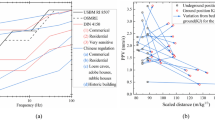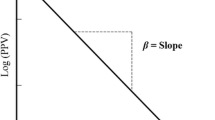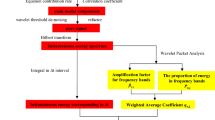Abstract
I would like to suggest a theoretical justification for the mathematical structure of some laws for predicting the maximum particle velocity vibration from blasting operations in the light of some basic notions of elastic and anelastic wave theory. Within this point of view, in dimensionally correct expressions, the terms pertaining to the rock, to the blast and to the seismic wave become evident and recognisable. A law is presented that can be used to forecast the maximum particle velocity on the basis of some blast design and rock parameters. Four tests of the proposed law performed with real data sets seem to confirm fairly well its reliability.
Similar content being viewed by others
Avoid common mistakes on your manuscript.
1 Foreword
Scaled distance (SD) laws are linear regression, in a log–log plane, between the maximum particle velocities (mm/s) (peak particle velocity or ppv) recorded at various distances r (m) during a blast and the distances normalised by the square root of the maximum charge per delay Q (kg) \({\left( {{\text{SD}} = r \mathord{\left/ {\vphantom {r {{\sqrt Q }}}} \right. \kern-\nulldelimiterspace} {{\sqrt Q }}} \right)}.\)
Usually, SD laws are presented as being derived from a more or less large amount of experimental data and are also defined as “site-dependent” relations. Some authors (Kim and Lee 2000; Tripathy and Gupta 2002) present the derivation of attenuation laws starting from the wave equation, relaxing the attenuation exponents with respect to the theoretical values.
Many kinds of these laws can be found in the literature; a quite exhaustive review of the existing laws can be found, for example, in Mancini et al. (2002). The coefficients resulting from regression claimed to be site-dependent and are often not dimensionally clear. Some elementary considerations based on seismic wave theory contribute to clarify their meaning, and a new formulation is given which explicitly shows the contribution of the various factors concurring to the problem: the source, the propagation medium and the wave-motion phenomenon. A test on four real data sets shows the satisfying performance of the proposed law.
2 Seismic wave energy theory and scaled distance laws
The energy associated with a seismic wave propagates far away from the source in a visco-elastic homogeneous medium according to the following equation (Telford et al. 1990):
where E and E 0 (J) are, respectively, the energy at distance r and r 0 (m), α (1/m) is the attenuation coefficient (Santamarina et al. 2001), ζ is a coefficient concerning the geometrical attenuation (often referred to as the spherical divergence, but sometimes improperly), taking into account the wave type: ζ = 2 for body waves, ζ = 1 for surface waves (Santamarina et al. 2001), r is the distance from the source to the measuring point and r 0 is a reference distance from the source.
As far as E 0 is concerned, it can be written as the explosive specific energy Φ (J/kg) times the weight of the instantaneous explosive charge Q (kg); in such a way, the delays are considered as non co-operating. While the meaning of r is obvious, it is the distance from the source to the sensor, r 0, that is less obvious. I propose to select r 0 as the diameter of the drill hole r h. With regard to the exponential term, firstly, I propose to ignore the r 0 term as, most of the time, r 0 ≪ r; then, I also propose to drop this term and to let it be a part of the dimensionless “site coefficient” K that will have to be determined; in this way, we explicitly drop also the anelastic behaviour of the medium. In doing so, especially when dealing with medium–high-quality rock, we could estimate this coefficient to be roughly equal to 0.8/0.95 (Santamarina et al. 2001).
Commercial instruments and common practice use to measure the particle vibration velocity v (m/s), and most of the laws relate the maximum value of this measure, ppv, essentially to Q (the quantity of instantaneous explosive charge in kg) and to the distance r (m) of the sensor from the blasting source. In the following, I will use with the same meaning v and ppv.
Following this guideline, it is possible to write Eq. 1 in terms of the aforementioned variables v, Q and r. Obviously, v, in this context, should be the “synchronous maximum,” \(v = \max {\left( {{\sqrt {v^{2}_{x} + v^{2}_{y} + v^{2}_{z} } }} \right)},\) to account for the whole energy, with v x, y, z being the particle velocity along three orthogonal directions x, y and z.
For E, which is an energy, we could write a specific energy as an energy by unit of volume Ψ (Aki and Richards 2002), such that:
where δ is the rock density (kg/m3).
So far, we still have to write the right-hand side of Eq. 1 in terms of energy by unit of volume. At this point, we have to define the volume to be used as the denominator of the right-hand side that could be referred to as the volume “scanned” by the wave from the source to the sensor.
Very likely, the maximum particle velocity usually measured is associated to Rayleigh waves. While body waves, in an isotropic, homogeneous half-space, have hemispherical wavefronts (ζ = 2), Rayleigh wavefronts are approximately cylindrical (ζ = 1). Actually, these waves carry, following an explosion, the largest part (about 65%) of the energy and have the maximum amplitudes (Foti 2000). Moreover, it can also be roughly stated that nearly all of the energy of Rayleigh waves travels to within a depth of about λ/3 (m) from the surface (Foti 2000). This latter figure suggests to us a way to define the height of the cylindrical volume. Following this criterion, Eq. 1 can be rewritten as:
but as the wavelength λ = c/f (c [m/s]) is the velocity of the propagation of the surface waves or, with good approximation, shear waves; f (Hz) can be taken as the dominant frequency), we get:
so that:
In this equation, the ratio in the first set of parentheses carries information on the blasting design, the ratio in the second set of parentheses on the acquisition geometry and in the middle, we have the numerator reporting a characteristic of the signal and the denominator reporting two meaningful characteristics of the rock. Finally, we have:
where K is the square root of K′.
We have found an SD-like expression where there is a term calculable with our knowledge on the rock and on the blast design. The Rayleigh wave velocity can be either measured (Foti 2000) or estimated as about 0.6 times the velocity of P-waves (a datum more readily available). As far as the frequency is concerned, it can only be reasonably evaluated after some tests, as the usual tests are carried out to determine the SD laws. Obviously, the result will be multiplied by 0.65 to account for the part of the energy pertaining to Rayleigh waves. The only term to be experimentally derived is K.
Now, if we set (Berta 1985): Q = 20 kg, Φ = 2,500,000 J/kg, r = 100 m, δ = 2,600 kg/m3, r h = 0.04 m, c = 1,800 m/s and f = 30 Hz, we get, with K = 1, v = 0.00325 m/s, which is of the right order of magnitude.
A sensitivity test on the proposed law can be easily performed using the rule of relative errors propagation:
where f(p i ) is the law, p i is the ith parameter in the law expression and σ(p i ) is the error on p i .
Applying Eq. 7 to Eq. 6, the weight of the error related to each parameter of the law can be calculated. Let us suppose that Q = 20 kg, Φ = 2,500,000 J/kg, r = 100 m, δ = 2,600 kg/m3, r h = 0.04 m, c = 1,800 m/s, f = 30 Hz and σ(Q) = 0.01Q, σ(Φ) = 0.01Φ, σ(r) = 0.3r, σ(δ) = 0.02δ, σ(r h) = 0.1r h, σ(c) = 0.1c and σ(f) = 0.3f. With this data, Eqs. 6 and 7 give v = 0.5 mm/s with an error of σ(v) = 44%. Table 1 shows the influence of the errors of the single factors on the final error both in the aforementioned realistic conditions and in a more theoretical environment considering a 10% error on each parameter. It can be easily seen how the main source of error is the definition of the correct path length of the seismic perturbation. However, this could be a challenging point in every SD law, as this path is usually considered as a straight line ignoring the real topographical paths. As far as the frequency value is concerned, it is the author’s opinion that only a few preliminary tests could indicate a realistic value to be used in the formula.
3 Testing on real data sets
To test the formula in Eq. 6, I use four real data sets from the following sources: Kahriman (2004) (data set 1); Kahriman et al. (2000) (data set 2); Cardu et al. (internal reports, data sets 3 and 4) and I compare the theoretical results (ppv) obtained with the proposed law with the experimental results measured in the field.
According to the information reported in the papers and in the reports, I used the parameters as shown in Table 2 to calculate the theoretical ppv.
The graph in Fig. 1 shows the capability of the theoretical ppv values, predicted using Eq. 6, in simulating all of the real data sets.
I then calculated the SD and the ppv values for each of the experimental data points of the four data sets with Eq. 6. Then, I calculated four SD laws for the experimental ppv and four SD laws for the calculated ppv.
Table 3 reports the eight equations. Figures 2, 3, 4 and 5 graphically show, for each data set, respectively, the experimental points, the SD law, with the 95% confidence intervals obtained from the experimental points, the proposed SD law.
Graph showing the ppv-SD laws obtained from: the real data set (black line) and the calculated data with Eq. 6 (dashed line). The thin continuous lines show the 95% confidence interval of the black line, that is, of the regression line from the experimental data. The crosses are the real data set from Kahriman (2004)
Graph showing the ppv-SD laws obtained from: the real data set (black line) and the calculated data with Eq. 6 (dashed line). The thin continuous lines show the 95% confidence interval of the black line, that is, of the regression line from the experimental data. The crosses are the real data set from Kahriman et al. (2000)
Graph showing the ppv-SD laws obtained from: the real data set (black line) and the calculated data with Eq. 6 (dashed line). The thin continuous lines show the 95% confidence interval of the black line, that is, of the regression line from the experimental data. The crosses are the real data set (1) from Cardu et al.
Graph showing the ppv-SD laws obtained from: the real data set (black line) and the calculated data with Eq. 6 (dashed line). The thin continuous lines show the 95% confidence interval of the black line, that is, of the regression line from the experimental data. The crosses are the real data set (2) from Cardu et al.
To give a synthetic view of the capability of the prediction of Eq. 6, a histogram of the differences between the experimental ppv and those calculated with Eq. 6 is shown in Fig. 6. The proposed law slightly overestimates the experimental values.
Histogram of the differences between ppv calculated with Eq. 6 and the experimental ppv
According to these four tests, Eq. 6 gives reasonable results but it seems to underestimate the ppv at small SD.
4 Conclusions
Starting from the theory of elastic waves, it can be shown that a scaled distance (SD) law may be almost rigorously derived, obtaining a dimensionally correct expression. This SD law can be used to predict the peak particle velocity (ppv) given some blasting, geological and geometrical parameters. According to the results of this study, the capability of prediction is nearly the same as for the usual a posteriori SD laws: this is clearly evidenced by Figs. 1–5. Moreover, as shown in Fig. 6, the proposed law is slightly more conservative than the a posteriori SD laws, thus, allowing for safer predictions. Within this new expression, the rock, the seismic wave characteristics, the blasting design and the acquisition geometry acquire a more precise meaning. The parameter K, which is to be determined, will then take into account the hardly definable variables, such as the seismic dissipative characteristic of the rock and the fraction of explosive energy lost due to vibration. The test on four real data sets taken from the literature shows that the theoretical values of ppv calculated with Eq. 6, amazingly, fall within (or slightly overestimate at long distances) the experimental data set with K = 1. Obviously, many other data sets should be tested and particular conditions of fractured rocks or thick overburdening could need tuning of the K parameter.
References
Aki K, Richards PG (2002) Quantitative seismology, 2nd edn. University Science Books, Sausalito, CA
Berta G (1985) L’esplosivo come strumento di lavoro. Italesplosivi, Milano
Foti S (2000) Multistation method for geotechnical characterization using surface waves. PhD thesis, Politecnico di Torino
Kahriman A (2004) Analysis of parameters of ground vibration produced from bench blasting at a limestone quarry. Soil Dynam Earthquake Eng 24:887–892
Kahriman A, Görgün S, Karadoğan A, Tuncer C (2000) Estimation particle velocity on the basis of blast event measurements for an infrastructure excavation near Istambul. In: Proceedings of the 1st World Conference on Explosive and Blasting Technique, Munich, Germany, September 2000
Kim D-S, Lee J-S (2000) Propagation and attenuation characteristics of various ground vibrations. Soil Dynam Earthquake Eng 19:115–126
Mancini R, Cardu M, Sambuelli L (2002) Vibrazioni indotte dallo scavo delle gallerie: sorgenti, misure, previsioni, rimedi e norme. In: Barla G, e Barla M (eds) Le opere in sotterraneo e il rapporto con l’ambiente. Patron Editore, Bologna, pp 293–327
Santamarina JC, Klein KA, Fam MA (2001) Soils and waves, Wiley, New York
Telford WM, Geldart LP, Sheriff RE (1990) Applied geophysics, 2nd edn. Cambridge University Press, Cambridge
Tripathy GR, Gupta ID (2002) Prediction of ground vibrations due to construction blasts in different types of rock. Rock Mech Rock Eng 35(3):195–204
Author information
Authors and Affiliations
Corresponding author
Rights and permissions
About this article
Cite this article
Sambuelli, L. Theoretical Derivation of a Peak Particle Velocity–Distance Law for the Prediction of Vibrations from Blasting. Rock Mech Rock Eng 42, 547–556 (2009). https://doi.org/10.1007/s00603-008-0014-0
Received:
Accepted:
Published:
Issue Date:
DOI: https://doi.org/10.1007/s00603-008-0014-0










